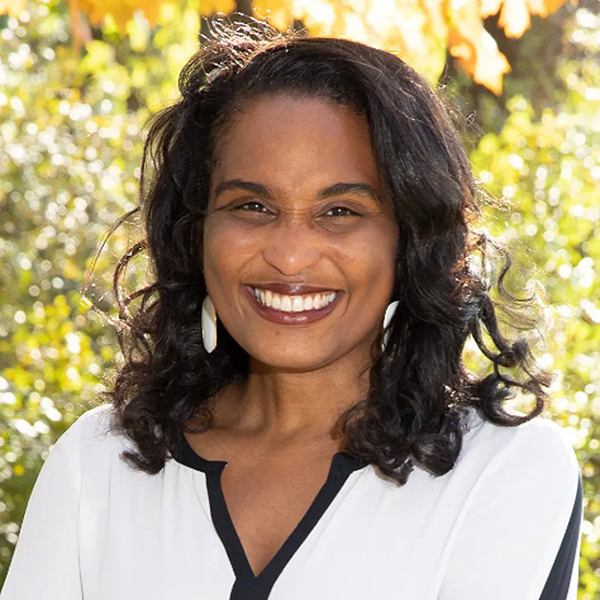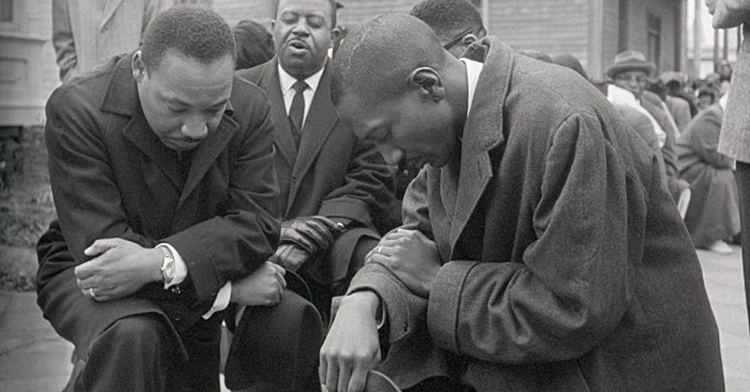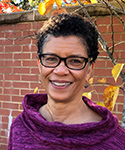Sometimes you lead by accident and other times by unwavering conviction. Dorothy Day did both, said Margaret Pfeil, an assistant professor in the Department of Theology at the University of Notre Dame.
 Pfeil specializes in Catholic social thought and the development of moral doctrine and also is a founder and resident of the St. Peter Claver Catholic Worker House in South Bend, Ind.
Pfeil specializes in Catholic social thought and the development of moral doctrine and also is a founder and resident of the St. Peter Claver Catholic Worker House in South Bend, Ind.
Catholic Worker houses were founded by Day (1897-1980) and seek to foster practice of the church’s traditional corporal works of mercy (to feed the hungry, give drink to the thirsty, clothe the naked, visit and ransom the captives, shelter the homeless, visit the sick and bury the dead) and spiritual works of mercy (to admonish sinners, instruct the ignorant, counsel the doubtful, comfort the sorrowful, bear wrongs patiently, forgive all injuries and pray for the living and the dead). Catholic Worker houses also advocate for social justice in their local communities and beyond.
Pfeil spoke in June 2009 with Faith & Leadership’s Jason Byassee about the Catholic Worker Movement, Dorothy Day, and an “anarchist” vision of leadership. At the time, she was teaching at Duke Divinity School’s Summer Institute: “Shaping the Beloved Community.”
Q: How did the Catholic Worker Houses of Hospitality get started?
It began during the Depression in New York. Day’s visionary partner Peter Maurin envisioned combining the works of mercy with scholarship. He and Day started a newspaper, which still sells today for a penny per copy. Day had been a journalist previously, and he came to appreciate her journalistic skills. And at first he wanted to run the paper. He envisioned Dorothy just doing the menial tasks involved in publishing. But she made it clear that this is going to be a joint effort. They wrote together about the making of a new society within the shell of the old.
Maurin wanted to light the fuse he saw leading to the dynamite of the social teachings of the church. We have these wonderful teachings, Maurin said, but who's actually practicing them? What about within the life of the institution of the church itself? Are we falling short? Aren't we called to something much more radical? The name, Catholic Worker, was a takeoff on the Communist newspaper, the Daily Worker. Maurin and Day would stand in Union Square and sell it. And they'd stand next to the Communists reading the Daily Worker and announce, “Well, read the Catholic Worker daily.”
Then, unexpectedly, workers started coming to the door where they published, saying, “This sounds great: hospitality, agronomic universities. Where do I find it?” Day said, “We put on a pot of coffee, opened the doors and have kept them open since.”
The houses of hospitality grew organically, in response to a need, through the mass communication of Day’s and Maurin’s ideas, which grew from their commitments of faith. That was a crucial moment. If Dorothy and Peter had said, “We're just writing this newspaper. That's all we're called to. We think these ideas are great, but that's as far as it goes,” there wouldn't be a Catholic Worker Movement today.
Q: You speak of the Catholic Worker house you live in as trying to institutionalize patterns of virtue rather than vice. How do you do that?
It has to happen at the level of relationship. At the Catholic Worker we try to welcome people as they are, without necessarily giving them a spiel about who Dorothy Day was. We try to live in a way that makes guests feel comfortable and welcomed. We want them to understand that we intend to be a house of hospitality (I’m sure we do this imperfectly, by the way). Hopefully after awhile people begin to feel comfortable and will start asking questions, “What is this all about? Why are you doing this? Who is this Dorothy Day?”
Q: You argue that, for Dorothy Day, Christians need to be doing the works of mercy and creating faithful institutions. What does that look like?
Dorothy was a Christian anarchist. By that she meant that we Christians tend to foist upon the state things that we need to take responsibility for at the personal level and as Christian communities.
Dorothy was envisioning something like what Bethel New Life does in Chicago under Mary Nelson -- gathering groups of people at the local level and meeting needs in a relational way. It's not meant to grow into a multi-billion-dollar corporation. It's just meant for the people who actually live in that area.
Maurin meant something similar with his idea of “agronomic universities.” They wanted to connect each Catholic Worker house with a communal agricultural setting where people who would never come into contact with the dirt can come to know creation in that way. All people then can leave the city and be recreated in their spirits through the land and with one another and get to know God more deeply. For people from very privileged backgrounds to engage in manual labor and get their hands dirty creates a sense of community where gradually the alienating effects of the Industrial Revolution can be healed.
For Dorothy, the Eucharist was key. She didn't mandate that everybody go to daily Mass, but she did herself. She invited people to join her, and then explained how important it was for her as the culmination of everything else. It didn’t have merely instrumental value. She didn't go to Mass to work more effectively. It was to go deeper.
Q: How could a Christian anarchist also be a pious Catholic? Didn’t she need also to submit to the authority of the church’s hierarchy?
Someone once asked her, “What would happen if the cardinal said to close the houses of hospitality tomorrow?” And she said, “Oh, I would obey that, but then I would also refer all requests for the 1,000 people we serve on the soup line, and the 200 people we house, and all the vegetables grown and requested on our farm, I would refer all that to the cardinal's office for him to deal with.”
Robert Ellsberg, the editor of Orbis Books now and editor of much of Dorothy’s work, was first shown he had gifts as an editor by Day herself. He was no more than 20 when Dorothy said, “I think you should edit the Catholic Worker newspaper.” When he first met her he wanted to ask her a good question. So he went up to her and asked, “Miss Day, how do you reconcile your Catholicism with your anarchism?” And she looked at him and said, “Well, it's never been a problem for me.” And that was it. He didn't know what else to say. That was the end of the conversation.
Q: How did she resolve the similar tension between being an “anarchist” and being faithful to Catholic tradition?
Tradition was a living thing for Dorothy, not a dead thing. Tradition did not mean for her that you grip things past in such a rigid way that they can’t be life-giving today. She looked back to the early church and said, “Why are we not doing this?” In the early church there was no usury, for example. In the early church we shared everything in common. In the early church Christians were pacifists. And so she modeled the Worker on this.
But Catholic Worker did this in the living church of today, as a prophetic witness, not in defiance against others. It wasn’t oppositional, though sometimes some perceived it that way. She absolutely understood herself to be within the tradition of the church, offering this witness in a very humble way.
When she insisted on pacifism even during World War II, and spoke on behalf of Catholic conscientious objectors to that war, she received a lot of criticism from members of the hierarchy in the Catholic Church. Her pacifism was taken as a personal affront by some in the hierarchy. They confronted her and said, “Who are you, a laywoman, to speak on behalf of this, on behalf of Catholic CO's?” And she said, “I'm speaking on behalf of laypeople. We're the ones who do the fighting.”
Forty years later, in “The Challenge of Peace,” the U.S. bishops named her personally as a witness of nonviolence in our times. That was a sea change, brought about partly because she remained faithful to that vision her whole life. That's her gift to the church.
The fact that subsequent generations keep adding to tradition is what makes it a living thing. She knew that in her bones. It was not merely an intellectual commitment. It was an incarnate commitment for her.
Q: You speak of your friend Neris Gonzalez as an exemplary leader. Who is she?
She is an advocate in El Salvador for popular education. She was working as a lay catechist, teaching peasants basic literacy skills, in hopes that they could then agitate for better prices for their crops. Those who opposed that work kidnapped and tortured her, and she lost her 8-month old unborn baby because of it.
Yet she continued through that country’s civil war to offer education. She sought asylum in the U.S. in the ’90s after further threats, and since then she has developed a new initiative in Chicago called Ecovida. This is a project designed to help inner city kids connect with the earth through sustainable agriculture in a way that would heal both them and the earth and the broken structures of their society.
A couple of years ago she did a 30-day retreat and used that as a time to imagine the next steps in her life. She decided it was time to learn English because she wanted to tell her own story. She's done a lot of interviews all over the world, all through translators, but her own voice is powerful. So she went to Eastern Mennonite University in Virginia to study English, and she's learning little by little and telling to tell more of her story herself.
That's a model for me. There's always something else on the horizon. She doesn't stay still. And she's willing to listen and to take into account new information, new ideas, new people, new possibilities and stoke her vision.
Q: Some of your students at Notre Dame will live a similar kind of radical commitment to communal living that you do at the Catholic Worker house. But most will not. What's your hope for students at Notre Dame who will become leaders in more conventional settings?
I would hope that they'd be true to themselves before God. I hope they will allow themselves to keep discerning how God is calling them because within these various institutional settings there is plenty of room for greater personal sacrifice and greater risk-taking in relationship with those who are the outcasts in our society.
I hope my students who grow into positions of leadership at institutions would gradually imagine better ways of participating in their institutions, pressing their boundaries and challenging them in order to transform them. Such institutions can help heal the divisions of race, class and gender that sunder our society and our churches. I want them to act out of faith.






